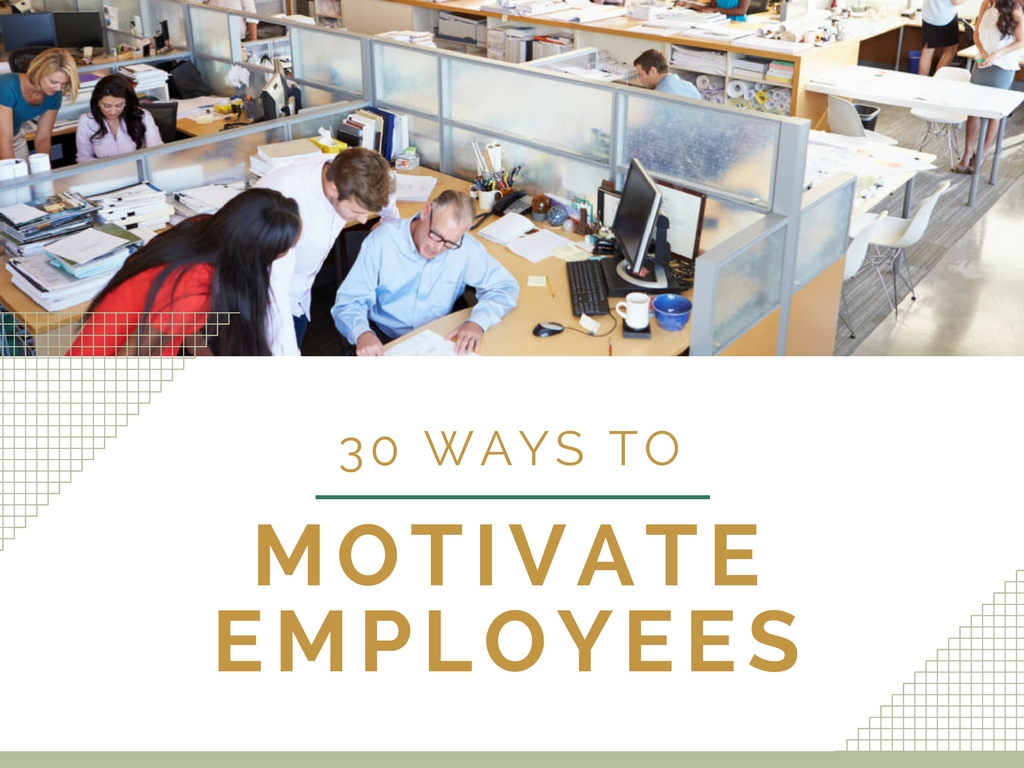
In today’s fast-paced, fast-changing world of business, it’s becoming increasingly difficult to keep employee morale high. However, with these 30 tips, you can improve your office environment, empower individuals, encourage team unity, and inspire hard work to ensure that your staff stays as motivated, dedicated, and productive as possible.
1. Implement Rewards
By creating and implementing a rewards system, you can encourage your employees to achieve benchmarks and strive to set better work goals for themselves. Even developing a “game-like” scenario where employees can earn a “badge” or “points” for committing to a certain task will create healthy competition throughout the workplace and boost morale. This is often called “gamification.”
2. Inspire Unity
Many employees pride themselves in their ability to work independently. However, by promoting company-wide unity within the office, you’ll inspire an environment where teamwork is encouraged. Make sure you emphasize how teamwork benefits both the individual and the company as a whole.
3. Encourage New Ideas
Perhaps one of the most detrimental things you can do to dampen employee morale is to resist new ideas. However, by encouraging your staff to come to you with their ideas and problem-solving solutions, you’ll inspire creativity, empower forward-thinking, and create an environment where your employees are excited to contribute to the success of the business.
4. Show Your Trust
By showing your staff that you trust and depend on them, they will rise to the challenges and overcome the obstacles that they face daily. A simple vote of confidence can inspire them to do their best. Micromanagement, on the other hand, shows a distinct lack of trust in your employees. You must balance being “in charge” with letting your employees do the jobs you hired them to do.
5. Create A Positive Environment
No one likes negativity, especially at work. Keep your employees motivated by creating a positive work environment, and you can start with your attitude. The measures you take to cultivate an enthusiastic and supportive persona will go a long way to fostering positivity in the workplace.
6. Empower Your Employees
If you want your employees to go above and beyond for you, you need to empower them to have more control over how they do their jobs. Encourage them to try new ways of conducting basic tasks, and reward innovation and “thinking outside of the box.” Give them the tools and the training they need to stretch their skills. Reward and recognize employees who show initiative.
7. Keep An Open Mind to New Methods
Do you ever get frustrated when using outdated, ineffective methods or technologies? Chances are your staff does, too. To keep morale high and employees motivated, keep an open mind when it comes to new ways of doing things. By welcoming and accepting new methods and utilizing new technologies, you can ensure that your business will stay ahead of emerging trends, improving your bottom line in the long run.
8. Put Boundaries on Boredom
Boredom is a very controversial topic, especially in the workplace. While many owners and managers fear that employees being bored horrifically hinders productivity, recent scientific studies prove that boredom often spurs innovative ideas and effective solutions. So while you’ll want to prevent your employees from spending endless hours daydreaming, giving them time to sit with their own thoughts isn’t always bad. Consider providing your employees with a place to go, or small non-work related things to do during downtime, so they can use their boredom in the most productive way possible.
9. Set Small Goals
Rather than setting lofty, far-fetched goals, work with your employees to develop small, reachable goals that inspire hard work throughout the office. By keeping these goals small and digestible – and rewarding employees for reaching them – your staff will understand that goals can be reached and that working hard does, in fact, produce benefits. It also gives your employees more frequent “wins,” which can keep them motivated when the going gets tough.
10. Facilitate A Balanced Workplace
While making your work environment a fun place undoubtedly helps keep employees motivated to work hard, balancing that liveliness with quiet downtime is important for maintaining levels of productivity and sanity. Additionally, your employees will need to be able to maintain prolonged focus to complete complex tasks, and a distracting workplace can kill their focus.
11. Acknowledge Professional Achievements
Being recognized by upper management or top-level executives for achievements and a job well done means a lot more to employees than you might think. They work hard, and it feels good to be acknowledged for their contributions. This attention also encourages others to work hard to receive the same praise. One particularly effective approach is to make a point of acknowledging professional milestones, such as a completed certification or a work anniversary.
12. Let them Know About Incentives Ahead of Time
When introducing new projects or goals, let your employees know of the incentives ahead of time. If your staff knows that there are rewards on the line for hard work, chances are they will work harder and stay motivated to reach those goals.
13. Celebrate Personal Milestones
Celebrating personal milestones and accomplishments helps your staff feel appreciated. If you know that an employee has just gotten engaged, or has achieved recognition in one of their personal hobbies, show them that you care by congratulating them. Even if it seems small or inconsequential, it will mean a lot to them.
14. Promote Purpose
Give your employees purpose. While this may seem vague, it’s as simple as outlining exactly what your expectations are for each employee. Your staff will have a better idea of what you’re trying to achieve as a company and what their individual role is in the broader plan. If they feel like they’re just punching a card every day, they won’t appreciate their role. But if they understand how they contribute to the success of the business, it will give their job purpose.
15. Go With The Flow
Being rigid and resistant when things don’t go as planned will discourage your employees and create a hostile work environment. Instead, when things don’t go as planned, keep an open mind, go with the flow, and be flexible. This will dissolve tensions and create a more productive, accepting work environment.
16. Be a Good Listener
One of the most powerful ways you can keep your employees motivated is to be a good listener. However, this can also be difficult. To improve your listening skills, create time in your schedule to listen to concerns, ideas, and anything else employees have to say. Consider having weekly roundtable discussions or implementing an open-door policy to encourage your employees to speak up. Cultivate your own personal listening skills by reminding yourself to be present in your conversations. Strive to understand what your team members are actually saying, instead of just thinking about how you’re going to respond.
17. Be Patient
Practicing patience will help you stop setting unreachable goals. It’s good to be results-oriented, but showing patience will give your employees the time to properly and effectively complete tasks and meet expectations.
18. Stay Energetic
Being enthusiastic is one of the best ways to keep morale and motivation high. By making an effort to promote a “work hard, play hard” culture, your staff will feed off of your positive energy and give you their best effort day in and day out.
19. Encourage Competition
Friendly competition is one of the best ways to boost productivity and keep employees motivated and engaged in their work. Developing monthly or weekly competitions is both healthy and will often increase camaraderie throughout your office.
20. Encourage Ownership
In order to make your employees feel invested in your company, you must inspire them to take ownership of their ideas, successes, and even failures. In turn, recognize their accomplishments and don’t be hesitant to give credit where credit is due.
21. Promote A Pet-Friendly Workspace
A new study shows that having pets in the workplace can boost productivity, lessen stress levels, and promote trust between staff members. Even if you don’t allow pets in the workplace all day, every day, consider designating a day or two each week where employees are welcome to bring their pets along.
22. Avoid Generalizing and Grouping
Managing a staff full of different personalities can be a challenge, but by treating and managing everyone the same, you’ll dampen personal expression and deter productivity. Knowing your employees on a more personal level and managing everyone individually is much more effective when it comes to keeping morale and motivation high.
23. Inspire Individuality
Along with managing each employee on an individual basis, it’s important to also inspire individuality throughout your office. By encouraging each employee to let their personalities shine, you’ll create a diverse and dynamic culture that helps inspire creativity. Allow employees to express themselves in the unique ways they dress and the accessories they bring with them to work. Each person is unique–celebrate that diversity!
24. Be Transparent
The importance of transparency in your business cannot be overstated. Give everyone on your team the opportunity to provide helpful feedback, clear up any confusion, and ask essential questions. Be open in your answers, and hold nothing back. This lets your employees know that they can trust you as a manager, and that you have their best interests at heart, which can be a big motivating factor.
25. Be Available and Accessible
Being available to your employees, even if it’s only for a short period of time each day, will help your staff feel appreciated and valued. Try extra hard to reach out to employees who may not necessarily get the attention they need or deserve, or who may be less inclined to reach out for your help when they need it.
26. Motivate Individuals, Not Just Teams
While keeping group morale high is important, it’s also vital for you to motivate individuals, too. In fact, by focusing on personally motivating employees, this contributes to the morale of broader teams. Don’t think you can just send out a company-wide email and be done with it. Talk one-on-one with employees on a regular basis, and find ways to motivate them individually. This will positively influence every aspect of your business, and is well worth the time investment.
27. Keep Things Interesting
Monotony is one of the biggest killers of motivation. Avoid this by stirring the pot and keeping things interesting. Ask your staff what types of things they would find inspirational and request ideas for ways you can keep morale high. Some ways to shake things up include having half-day Fridays, switching up the dress code, or hosting a happy hour every Wednesday.
28. Let Employees Lead
Give each staff member the chance to take the reigns on important things like meetings or big projects. Doing this will help empower your employees and encourage them to take ownership of their opinions, efforts, ideas, etc. They will be more motivated to bring their ideas and vision to life.
29. Embrace Change
Fighting change is hard, so why even try? By embracing change – whether it be in marketing tools like social media or or mobile applications – you’ll find that your employees will likely do the same. Embracing new technology and the changing tides of business will help create a more flexible working environment and up productivity. Also, your company will stay poised to meet whatever challenges come your way.
30. Value Tradition
Starting and keeping traditions is one of the best ways to keep your employees feeling motivated, valued, and part of something greater than themselves. Consider starting an office tradition, like an annual company party, a monthly dinner night, a company volunteer day, etc. and encourage each employee to participate.
Implementing all of these tips into your leadership efforts will take time and practice, but by dedicating yourself, you will find that your staff feels more valued, more motivated, and more productive than ever.






 157 million. That’s the number of
157 million. That’s the number of 

